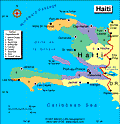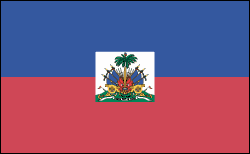Read this country profile to learn about Haiti's history, government, geography and economy. It includes information about the devastating January 2010 earthquake.
| Facts & Figures | |
|---|---|
| |
President: René Préval (2006) Prime Minister: Jean-Max Bellerive (2009) Land area: 10,641 sq mi (27,560 sq km); total area: 10,714 sq mi (27,750 sq km) Population (2009 est.): 9,035,536 (growth rate: 1.8%); birth rate: 29.1/1000; infant mortality rate: 59.7/1000; life expectancy: 60.7; density per sq km: 323 Capital and largest city (2003 est.): Port-au-Prince, 1,764,000 (metro. area), 1,119,000 (city proper) Monetary unit: Gourde |
|
Geography
Haiti, in the West Indies, occupies the western third of the island of Hispaniola, which it shares with the Dominican Republic. About the size of Maryland, Haiti is two-thirds mountainous, with the rest of the country marked by great valleys, extensive plateaus, and small plains.
Government
Republic with an elected government.
History
Explored by Columbus on Dec. 6, 1492, Haiti's native Arawaks fell victim to Spanish rule. In 1697, Haiti became the French colony of Saint-Dominique, which became a leading sugarcane producer dependent on slaves. In 1791, an insurrection erupted among the slave population of 480,000, resulting in a declaration of independence by Pierre-Dominique Toussaint l'Ouverture in 1801. Napoléon Bonaparte suppressed the independence movement, but it eventually triumphed in 1804 under Jean-Jacques Dessalines, who gave the new nation the Arawak name Haiti. It was the world's first independent black republic.
Unrest Stifles Development
The revolution wrecked Haiti's economy. Years of strife between the light-skinned mulattos who dominated the economy and the majority black population, plus disputes with neighboring Santo Domingo, continued to hurt the nation's development. After a succession of dictatorships, a bankrupt Haiti accepted a U.S. customs receivership from 1905 to 1941. Occupation by U.S. Marines from 1915 to 1934 brought stability. Haiti's high population growth made it the most densely populated nation in the Western Hemisphere.
In 1949, after four years of democratic rule by President Dumarsais Estimé, dictatorship returned under Gen. Paul Magloire, who was succeeded by François Duvalier, nicknamed “Papa Doc,” in 1957. Duvalier's secret police, the “Tontons Macoutes,” ensured political stability with brutal efficiency. Upon Duvalier's death in 1971, his son, Jean-Claude, or “Baby Doc,” succeeded as ruler of the poorest nation in the hemisphere. In the early 1980s, Haiti became one of the first countries to face an AIDS epidemic. Fear of the disease caused tourists to stay away, and the tourist industry collapsed, causing rising unemployment. Unrest generated by the economic crisis forced Baby Doc to flee the country in 1986.
Despite Intervention, Haiti's Infrastructure Remains in Tatters
Throughout the 1990s the international community tried to establish democracy in Haiti. The country's first elected chief executive, Jean-Bertrand Aristide, a leftist Roman Catholic priest who seemed to promise a new era in Haiti, took office in Feb. 1991. The military, however, took control in a coup nine months later. A UN peacekeeping force, led by the U.S.—Operation Uphold Democracy—arrived in 1994. Aristide was restored to office and René Preval became his successor in 1996 elections. U.S. soldiers and UN peacekeepers left in 2000. Haiti's government, however, remained ineffectual and its economy was in ruins. Haiti has the highest rates of AIDS, malnutrition, and infant mortality in the region.
In 2000, former president Aristide was reelected president in elections boycotted by the opposition and questioned by many foreign observers. The U.S. and other countries threatened Haiti with sanctions unless democratic procedures were strengthened. Aristide, once a charismatic champion of democracy, grew more authoritarian and seemed incapable of improving the lot of his people. Violent protests rocked the country in Jan. 2004, the month of Haiti's bicentennial, with protesters demanding that Aristide resign. By February, a full-blown armed revolt was under way, and Aristide's hold on power continued to slip. The protests, groups of armed rebels, and French and American pressure led to the ousting of Aristide on Feb. 29. Thereafter a U.S.-led international force of 2,300 entered the chaos-engulfed country to attempt to restore order, and an interim government took over. In September, Hurricane Jeanne ravaged Haiti, killing more than 2,400 people. Lawlessness and gang violence were widespread, and the interim government had no control over parts of the country, which were run by armed former soldiers.
Political Turmoil Continues
After numerous delays, Haiti held elections on Feb. 7, 2006. The elections, backed by 9,000 United Nations troops, were seen as a crucial step in returning Haiti to some semblance of stability. Former prime minister and Aristide protegé RenéPréval, very popular among the poor, was seen as the favorite. But when the election count indicated that Préval's lead over the other candidate was dropping and that he would not win an outright majority, Préval contested the election and charged that “massive fraud and gross errors had stained the process.” On Feb. 14, the interim government halted the election count, and the following day, after the votes were retabulated, Préval was declared the winner.
In April 2008, Prime Minister Jacques-Édouard Alexis was removed from office by the Senate, which held him responsible for the poor economy. President René Preval designated Ericq Pierre as the new prime minister, but the lower house of Parliament rejected Pierre. In July, Parliament approved the nomination of Michèle Pierre-Louis for prime minister and she became the second woman prime minister of Haiti.
The Senate voted in November 2009 to oust Prime Minister Michele Pierre-Louis, who was considered by international donors as a competent leader who could efficiently and effectively use aid to improve the infrastructure of Haiti and boost the economy. The Senate, however, claimed that she had not done enough to lift Haiti out of its near constant state of misery. She was replaced by Jean-Max Bellerive.
Devastating Earthquake Exposes Weaknesses in Infrastructure
The beleaguered country was dealt a catastrophic blow in January 2010 when a magnitude 7.0 earthquake struck 10 miles southwest of Port-au-Prince, the country's capital. It was region's worst earthquake in 200 years. The quake leveled many sections of the city, destroying government buildings, foreign aid offices, and countless slums. Assessing the scope of the devastation, Prime Minister Préval said, "Parliament has collapsed. The tax office has collapsed. Schools have collapsed. Hospitals have collapsed." He called the death toll "unimaginable," and fatalities are expected to near 100,000. The United Nations mission in Haiti was destroyed, 16 members of the UN peacekeeping force in Haiti were killed, and hundreds of UN employees were missing. International aid poured in, and the scope of the damage caused by the quake highlighted the urgent need to improve Haiti's crumbling infrastructure and lift it out of endemic poverty—the country is the poorest in the Western Hemisphere.








